These designs use motifs other than standard knotwork or keywork, or
are combinations of motifs. In addition, I've added some animal-based designs
(known as "zoomorphics" in [BainG]). I've tried to disclose the original sources
used for each of these where possible. Note that all secondary source
documents are listed by author in square brackets, with the full name found
on the Class Bibliography page.
Clip art materials using these motifs are divided into the
following categories:
These images include both horizontal separator "lines" and vertical
backgrounds with left-hand borders. Please click on the bordered thumbnails
to see the full-size images.
Where possible, the components of the borders are provided. That is, the
left edge, the center (middle) repeated section, and the right edge are
provided as separate files. These may be combined to make borders of any
size desired.
1. |
The following borders are based on a
combination of simple key and knot patterns. The key pattern is
used on a number of Celtic MS and stones (see [BainG] page
75, plate 1 and Keywork Border 1
for examples). The knotwork pattern is from the
Monifieth Stone (see [BainI] page 52-53 and
Knotwork Tile 7 for examples).
|
a.
 Left:
Left:  Middle:
Middle:  Right:
Right: 
|
a.
 Left:
Left:  Middle:
Middle:  Right:
Right: 
|
2. |
The following borders are based on a key pattern
originally from Kells (unknown Folio) that I took from [BainG] page
78,plate 7. For other instances of this key pattern, see
Keywork Border 2. The
knotwork part is based on a pattern I originally found in
[BainG] page 32, plate 7. The original pattern is from
Durrow folio 125V, seen in [BainI] page 54. |
a.

|
b.

c.
 |
3. |
The original source for knotwork part of these
panels is unknown, but I found it in [BainG], pg. 35, Plate 13 LR, and
[Meehan2] pages 140, and 141. Tiles from this patterrn may be
found on: Knotwork Tile 8. [Meehan2] refers
to these as "Spiral Knots", as he does the one from the Monifieth
Stone (see [BainI] page 52-53 and
Knotwork Tile 7).
It is referred to in [Meehan2] as a "spiral knot", so I thought
to pair it with an actual spiral, this one from a Kells border.
|
a.
 Left:
Left:  Middle:
Middle:  Right:
Right: 
|
b.
 Left:
Left:  Middle:
Middle:  Right:
Right: 
|
1. |
|
2. |
|
3. |
The following tiles were designed using a combination of
keywork from the arm of the cross on the Aberlemno Stone seen
as a stand-alone keywork tile on the Keywork
Designs page (Tile 4), plus a knotwork pattern from the Book
of Kells, Folio 29r, rendered using doubled knotwork to better
match the keywork spacing. For details on doubled knotwork, see the
Line Treatments section from the
knotwork tutorial pages. |
a.  b.
b. 
| |
4. |
These tiles use a novel combination of triangular knotwork
from the Bore-Stone of Gask (see
Triangular Designs (Tile 7) for a stand-alone version),with a border
originally found in Lindisfarne folio 27 (and elsewhere-see
Knotwork Designs (Tile 11) for a stand-alone
version), doubled in the original. These tiles are rendered in "carved
stone" textures. |
a. 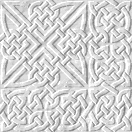 b.
b. 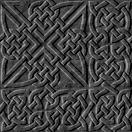
| |
5. |
|
6. |
These tiles are based on a combination of the top cross on
Kells folio 291V (doubled in the original-see [BainI] page 85)
with a design from the Ulbster Stone (see [BainG] page 42 and
Triangular Knotwork Tile 2). Tile 6.a
gives the effect of caved stone, while 6.b and c try to attain the look
of painted vellum. |
a. 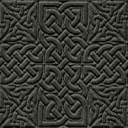 b.
b.  c.
c. 
| |
7. |
These tiles are based on a combination of the "chevron" style
variation of the Nigg Stone keywork pattern (also found in the
Book of Kells F29V and shown in [BainG] page 78, plate 7) and
knotwork from the Book of Durrow, analyzed both in [Meehan2] pg.
148 and [BainG] pg. 33. The keywork original can bee seen on the
Keywork Designs (Tile 7) page, and the
knotwork on Knotwork Designs (Tile 29)
page. The tiles are simply rendered in gray-scale shades. |
a.  b.
b. 
| |
8. |
The tiles below are based on a three-way combination of other designs:
- Triangular Knotwork: Based on [Meehan2] Triagular Knot 9, pg. 151 (also see
Triangular Tile 13).
- Knotwork Border: Maiden Stone pattern,
Knotwork Designs (Tile 18). This version uses
doubled bands to better link up with the knotwork and keywork parts of the
pattern.
- Keywork: Based on design from Golden Grove, Carmarthen, Wales.
Also see [BainI2] Celtic Key Patterns pg. 47 and
Keywork Tile 5.
The tiles are simply rendered in gray-scale shades. |
a. 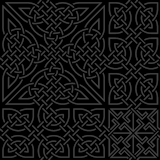 b.
b. 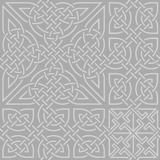
| |
9. |
These tiles are a combination design, including knotwork based on
the "Celtic Lover's Knot" (also found on the Meigle Stone number 5,
see [BainI] page 104 for an analysis, and Knotwork
Tile 13 for the stand-alone tile), plus a keywork pattern from the
Book of Kells (unknown folio), found in [BainG] page 80 (see
Keywork Tile 3 for the stand-alone tile). The
tiles are rendered in gray-scale shades. |
a. 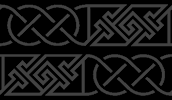 b.
b.  c.
c. 
| |
10. |
Another three-way combination of designs:
- Triangular Knotwork: Britford Stone. See [BainG] page 41
Plate F.1 for an analysis of this pattern, and the
Triangular Knotwork page (Tile 4) for the
stand-alone version.
- Spiral Border: Book of Kells pattern, seen in [BainG]
Plate 9, pg. 65 andSpiral Border 1.
Some tiles "stack" two of these to add depth to the border.
- Keywork: Based on design from Golden Grove, Carmarthen, Wales.
Also see [BainI2] Celtic Key Patterns page 47 and
Keywork Tile 5.
The tiles are rendered in gray-scale shades, "carved stone", and
"gold jewelry".
|
a. 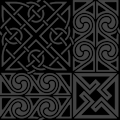 b.
b. 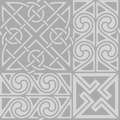 c.
c. 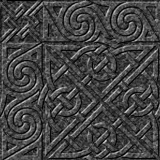 d.
d. 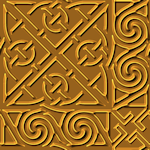
| |
11. |
Here is a first attempt at animal-themed tiles in the
Insular Celtic style; what G. Bain calls "zoomorphic". These are
based on a design from the Book of Lindisfarne Folio 138v.
The tiles are rendered in gray-scale shades.
|
a. 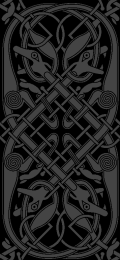 b.
b. 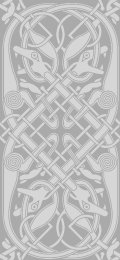
| |
12. |
Here is another attempt a "zoomorphic" (per [BainG] page
101), animal-themed tile in the Insular Celtic style. These are based
on a design from the Book of Lindisfarne Folio 139r. The tiles
are simply rendered in gray-scale shades.
|
a. 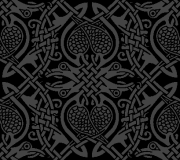 b.
b. 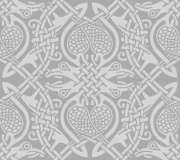
| |
13. |
These tiles are another attempt a "zoomorphic" (per [BainG]
page 101), animal-themed tile in the Insular Celtic style. These are based
on a "dog" border design from the Book of Lindisfarne Folio 13r.
The tiles are simply rendered in gray-scale shades.
|
a.  b.
b. 
| |
14. |
These tiles are also "zoomorphic" (per [BainG]
page 101), animal-themed designs in the Insular Celtic style. These are
based on an overall background design from the Book of
Lindisfarne Folio 26v. The tiles are simply rendered in gray-scale
shades.
|
a. 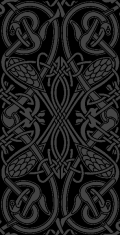 b.
b. 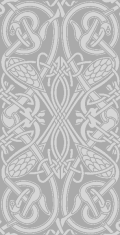
| |
15. |
These are another "zoomorphic" (per [BainG] page 101), animal-
themed set of tiled images in the Insular Celtic style. These are based
on an panel from the Book of Lindisfarne Folio 27r. The tiles
are simply rendered in gray-scale shades.
|
a.  b.
b. 
| |
16. |
Another combination of designs:
- Triangular Knotwork: Based on a pattern from the Ulbster Stone.
See [BainG] page 42, Plate G for an analysis of this pattern and
Triangular Tile 2.
- Knotwork Border: Based on a design from the Book of Kells,
Folios 2v, 129v, and 290v, and Lindisfarne F210b (see [BainI] pgs.
105 & 107 and Knotwork Tile 21).
- Keywork: Based on design from Golden Grove, Carmarthen, Wales.
Also see [BainI2] Celtic Key Patterns page 47 and
Keywork Tile 5.
The tiles are rendered in gray-scale shades and "gold jewelry/wire".
|
a.  b.
b.  c.
c. 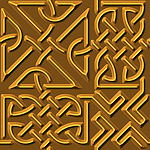 d.
d. 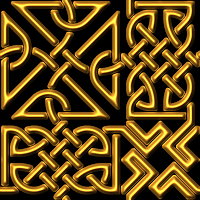
| |
17. |
These tiles are a novel combination design, including knotwork based
on a design from the Book of Durrow Folio 86r (see [BainI] page 104 for
an analysis and Knotwork Tile 14), plus a keywork
pattern from the Rosemarkie Stone (see Keywork
Tile 16 for the stand-alone pattern). The tiles are rendered in gray-scale
shades. |
a.  b.
b. 
| |

